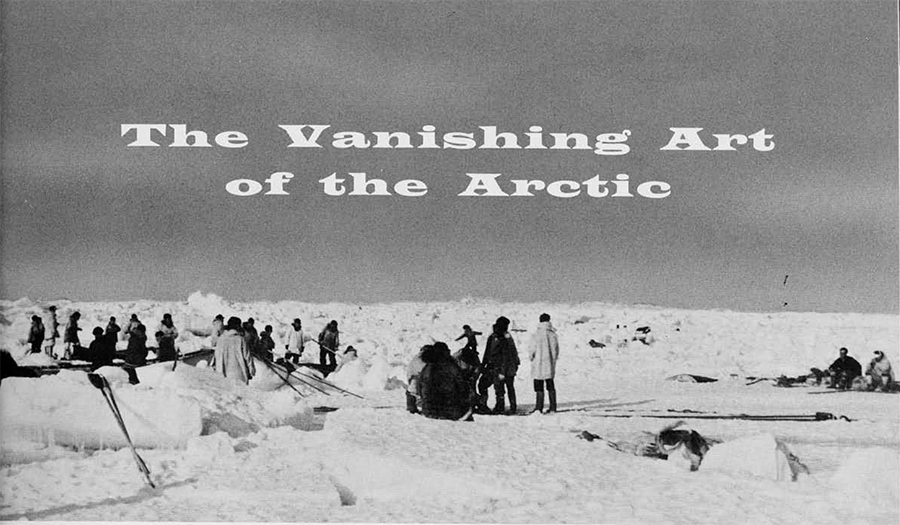
But of the land on the other side of the bald men none can give any trustworthy account because it is shut off by a separating wall of lofty trackless mountains, which no man can cross. But these bald men say– which, however, I do not believe– that men with goat’s feet live on the mountains, and on the other side of them other men who sleep six months at a time…The whole of the country which I have been speaking of has so hard and severe a winter, that there prevails there for eight months an altogether unsupportable cold…even the sea freezes…
They first pointed to the ships, eagerly asking, what great creatures those were. Do they come from the sun or the moon? Do they give us light by night or by day? Sacheuse told them that he was a man, that he had a father and mother like themselves; and pointing to the south, said that he came from a distant country in that direction. To this they answered, “That cannot be, there is nothing but ice there.”
All of the desolate shores of the Arctic Sea have now been charted. No lost tribes like the Polar Eskimo remain to be discovered. We now know that men were living along the Arctic shores several thousand years before the birth of Christ and that by 1500 B.C. they lived much further north than any men live today. But the history of man’s conquest of the Arctic remains a mystery. Several distinct races like the Lapps, Samoyeds, Yukaghir, and Eskimo have long been adapted to Arctic living. There are students of the northern people who believe that all of these tribes carry on the cultural tradition of an ancient circumpolar stone age which may be derived from the reindeer hunters of Magdalenian times in western Europe. Others maintain that the Eskimo, the most northern and the most famous of all Arctic people, originated in North America and have no connection with other Arctic dwellers in Asia.
No primitive race in the world has been the subject of more study and speculation than the Eskimo. They are the Skraelings who met and fought with the Norsemen in West Greenland in the 13th century, the men who attacked one of the first European ships to pass through Bering Strait, and the men who made it possible for Peary to discover the North Pole. Eskimos in East Greenland speak the same tongue as those at East Cape, Siberia. For the most part they cling to the shores of the Arctic and the Bering Seas, but some manage to live inland on the Barren Grounds of Northern Canada and Alaska. All are hunters of land and sea mammals. We think of them as men of a common language, race, and culture, but find it exceedingly difficult to give a satisfactory definition of Eskimo culture. And there are at least two distinctive physical types.
Some of our Russian colleagues who study the northern people believe that the Eskimo are originially Americans because they find no trace of them west of the Kolyma River on the Siberian coast. Nonetheless, most American experts believe their origin is to be sought in Siberia. Thus, at the present time, they are disclaimed by both the East and the West. In this dilemma, the Russian archaeologist, S.I. Rudenko has suggested that they may be descendents of sea people who moved northward along the Pacific coast of Asia.
In recent years many archaeologists have excavated scores of ancient sites in Siberia, Alaska, Canada, and Greenland, piecing together the tangible evidence of a long history of Arctic settlement, and each year the story becomes more complex. There is today no generally accepted scheme of northern history nor any real agreement on interpreting the evidence in the Eskimo regions. However, in brief, it is possible to say that men had settled the Bering Strait region by at least three or four thousand B.C., that they had settled Greenland by 2000 B.B., and that Arctic culture has not been static. The Arctic has not been a refuge of ancient Stone Age people. Culture change is a characteristic there as it is in the rest of the world.
There is at present evidence of an ancient Stone Age culture related to the Mesolithic of the Old World, a paleo-Eskimo culture characterized by the use of chipped flint tools, and a neo-Eskimo culture characterized by the use of polished slate tools, which survives to the present day. But within these three time horizons numerous distinct stages can be recognized from the remains excavated in many archaeological sites.
Through the technique of radiocarbon analysis we now have some debatable dates for the three time horizons. The ancient Stone Age appears to be earlier than 2000 B.C. (absolute dates are not yet possible), the paleo-Eskimo stage was sometime between 700 B.C. and A.D. 300, and the neo-Eskimo stage represents the period from at least A.D. 300 to the present. But we do not know when the Eskimo first appeared in this time sequence. Skeletons from graves of the earliest neo-Eskimo times found at East Cape, Siberia, very closely resemble those of the living Eskimo. Skeletons from graves of a late paleo-Eskimo stage found at Point Hope, Alaska do not, and therefore suggest that those we have called the paleo-Eskimo are not physically Eskimos, even though they may have spoken the Eskimo language. There are no skeletons from the ancient Stone Age; hence, we have no way of knowing whether the people were physically or linguistically Eskimo. Cultural connections suggested by the kinds of stone tools found in the ancient sites are very tenuous.
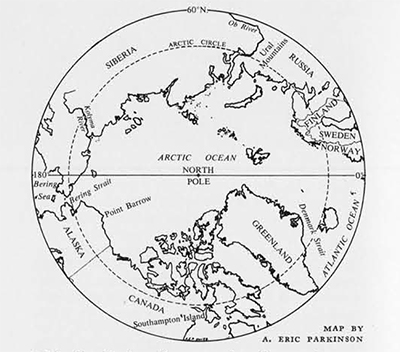
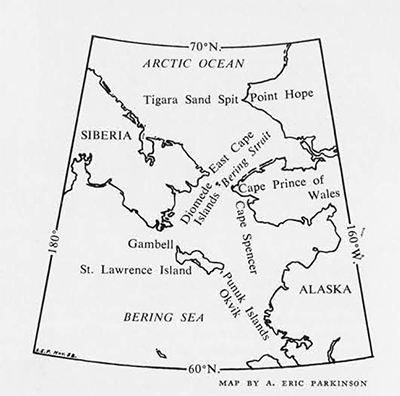
If you examine a polar map with the North Pole at its center, a familiar type of map now that air travel across the Arctic has been established, you will see the Arctic Ocean as an enclosed, ice-covered body of water surrounded for the most part by low, barren, tundra lands.
This icy basin disgorges floe ice each year through Bering Strait into Bering Sea, and through the Denmark Strait into the Atlantic. Primitive fur-clad hunters have penetrated to the frozen tundra coasts around the entire rim of the sea. They are of different races and they speak different languages but they have in common many cultural traits which may be no more than necessary adaptations to the same environment. Of all these different groups it is the Eskimo who cling most closely to the edge of the ice and who have developed a unique Arctic culture. For most of them seals and reindeer are the bases of life.
But in the region of Bering Strait there is a phenomenon of nature which provides the sea-hunting Eskimo with an abnormally rich harvest. Here walrus and bow-head whales pour through the funnel between the Bering and Arctic Seas, northward each spring and southward each fall.
Now depleted by commercial hunters, the yearly migrations give only a suggestion of the vast numbers of these animals which once passed through the Strait. It is thus no accident that large permanent villages of Eskimo are located at such points as East Cape, Siberia and Cape Prince of Wales, the Diomede Islands, and Point Hope, Alaska, where they migrations would be intercepted. Some of these villages may be as old as Rome. Certainly several of them have been permanently occupied for nearly two thousand years. This narrow strait between Asia and American may mark the region in which Eskimo culture, as we know it, originated. At least, this is where we find the most ancient remains, the most complex cultures, and most of the evidence of cultural change and development. It is also this region which produces the finest examples of the ancient classic art of the Eskimo.
We Arctic diggers during the past twenty-five years have defined several distinct forms of ancient art work in the Bering Strait region, known as Ipiutak, Old Bering Sea, Okvik, and Punuk styles. All fall within the period of the first millennium after Christ, so far as we can tell at present from radiocarbon analysis of organic material in the ruins excavated about the Strait.
What we believe to be the most ancient style was discovered at Point Hope, Alaska, in 1939 by Dr. Helge Larsen, Dr. Louis Giddings, and me at the largest ruined settlement so far known in the Arctic. More than 600 house ruins extended over an area nearly a mile in length and the graves of these ancient inhabitants were found along the Arctic shore for a distance of about four miles to the east of the house ruins.
We have named this ancient site Ipiutak after an Eskimo name for a section of the Tigara sand spit, and we speak of it as a settlement of paleo-Eskimo people who lived in the American Arctic some centuries before and some centuries after the time of Christ. But the origin and the history of these people remain a mystery. A clue may be found in the distinctive Ipiutak style of sculpture and incised design. Of the 10,000 manufactured objects found in the Ipiutak ruins at Point Hope, Alaska, no single piece is more significant than the small ivory carving of a cub walrus. Across Asia from the Ordos region in China to the shores of the Black Sea, have been found examples of an art form known as the Siberian Animal Style. Originally associated with the Scythian people of South Russia who produced the finest examples in bronze and gold during the 6th and 5th centuries B.C., it is sometimes referred to as Scythian. But with extensive archaeological work in northern Asia it is apparent that many ancient and primitive people in the vast temperate and northern regions of the Eurasian continent produced similar figures of animals in bone and ivory as well as in metal. it is most commonly associated with nomadic people of the steppe regions and with the century preceding the Christian era, but related forms habe been found in the northern forested regions of the Ural Mountains and even as far north as the mouth of the Ob River on Siberia’s Arctic shore.


At Ipiutak we found numerous engraving tools with an ivory or antler shaft slotted to receive a cutting bit. In some were set a beaver’s tooth with the chisel-shaped cutting edge not unlike a dental tool. In others the slot was much too narrow to receive a beaver’s tooth. It was obvious that only a metal blade could be used in such thin slots, but only in one engraving tool at Ipiutak did we find the oxified remains of wrought iron or steel. Later, at Cape Spencer, Helge Larsen discovered another burial site of the Ipiutak period with fragments of metal blades inset in ivory implements. Siberian steel of iron must have been precious on the north Alaska coast in the fourth century after Christ, but it was there in small quantities at least.
Most of the elaborately carved and engraved objects at Ipiutak were found in the burials. Some were exceedingly rich with scores of objects lying about one or more skeletons– others contained no burial equipment whatever. Some skeletons lay in long-walled tombs, others in shallow graves which had been much disturbed by animals or by weathering. Most dramatic were those skeletons equipped with ivory eyes– spool-shaped or conical ivory plugs inset with jet to represent eye pupils– and with carved nose plugs and mouth covers. There was obviously an elaborate burial cult, at least for certain individuals who we assume were shamans, and many of the carvings probably were symbolic of supernatural powers. We know that shamans among many of the Siberian tribes customarily hung about their clothing innumerable figures representing their spiritual powers. Shamanism is an ancient cult in Asia and there is good reason to suppose that many of the Ipiutak carvings have to do with its practice.
In one grave we found the skull of a loon with ivory plugs set in the eye-sockets and an ivory ring about the beak. From this and from the innumerable legends about the loon prevalent among the Arctic tribes, we assume that many of these objects symbolize the loon. The shapes are graceful and light with cut-out sections. Many are engraved with such familiar design patterns as the circle with tangential lines illustrated here. Normally one surface is decorated and the other flat and plain, which suggests that they were affixed to something like a bag, a box, or a garment.
A set of tubes cut from caribou antlers also suggest the paraphernalia of Shamanistic practice. They were carefully hollowed out so that the walls are exceedingly thin. One was elaborately engraved over most of the surface, others were without carving or engraving. That illustrated here is both carved and engraved to represent the head of a caribou. The eye is inset with jet.
The strange rake-like object of ivory was found on the Arctic coast of Alaska and probably comes from the Ipiutak cemetery at Cape Spencer. There is no implement made by historic Eskimos which could explain its function. Two similar implements were found at the Ipiutak site at Point Hope but neither of those is carved in such an elaborate form. The guard which fits neatly over the teeth is unique and puzzling. Like the carving of the cub walrus, this has a peculiarly important significance, because the central figure, representing the head of a polar bear face-on suggests a stylistic connection with bear carvings found in the region of the Ural Mountains.
There is an ancient cult and a ceremonialism associated with the bear in the far north which was practiced among many native peoples in Asia and America. It is possible that such a stylized design of a polar bear may indicate a distant cultural connection between northwestern Siberia and northwestern Alaska as well as the existence of the ancient and wide-spread bear cult among the mysterious people of Ipiutak as early as the 4th century A.D.
In 1926 Diamond Jenness of the Canadian National Museum discovered some remarkable ivory carvings at ancient sites on Bering Strait which were so unlike familiar Eskimo work and so distinctive in style that he could assume without further evidence the existence of an Old Bering Sea culture notable different from that of the historic Eskimos. His conclusions were borne out by the work of Collins, Geist, Rudennko, and others on St. Lawrence Island and at East Cape, Siberia. However, strange as it may seem, not a single site or deposit has yet been found which contains only this particular style of art. On St. Lawrence and at East Cape where most of the excavated objects were found, it occurs in houses or sites with later material, and we have yet to discover a “pure” deposit which could clearly isolate this style in a specific period.

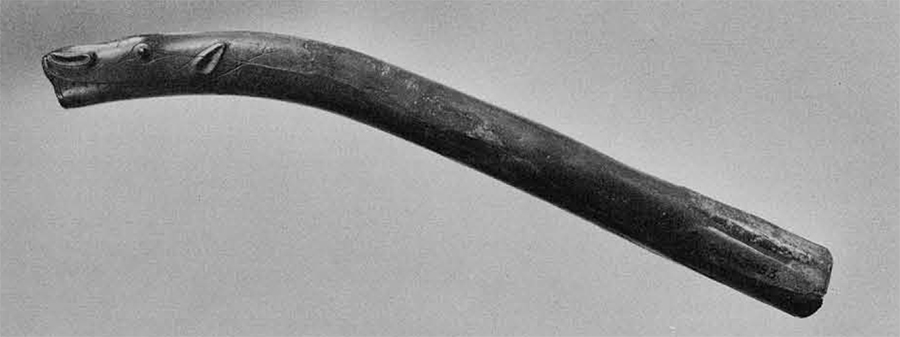
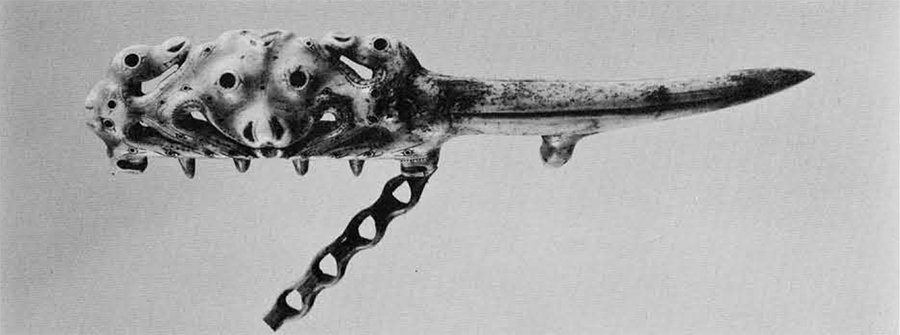

Hence its relative age in the sequence of northern art styles remains a puzzle. We do know that during the early centuries of the Christian era there lived about Bering Strait a people who dwelt in permanent houses in large settlements on St. Lawrence Island, East Cape, Cape Prince of Wales, and the Diomede Islands. They were great hunters of walrus, seals, and whales. They were a sea-people who made pottery and polished slate tools not unlike similar utensils found along the northeastern coast of Asia, but very different from the most common tools and utensils made by the people of Ipiutak on the northern coast of Alaska. But like the Ipiutak people they were masters of the art of carving and engraving delicate objects in ivory. Some of the designs are similar although we can easily distinguish them.
The curious winged object illustrated here is very characteristic of the Old Bering Sea period. Such objects are remarkable like the stone “bannerstones” made by Indians of the eastern United States. There is no certain knowledge of their use or significance but in the collections of the University of Alaska Museum there is a whole series of related objects from Okvik, Old Bering Sea, and Punuk periods which, taken together, give a clue. All have sockets at each end of the central section. It is possible that they are counterweights affixed to the butt of throwing spears, with the larger socket to receive the spear butt and the smaller socket to receive the hook of a spearthrower. The most elaborate and the largest are invariably engraved in the Old Bering Sea style.
One of the finest examples of this style is an ivory socket-piece for a harpoon, now in the collections of the U.S. National Museum. It was affixed to a harpoon shaft to receive the small foreshaft which joins the toggle harpoonhead. The modelling and incising delineate reptile-like heads and snouts with raised bosses and sockets in the position of eyes or nostrils. It is this curvilinear style with punctate bosses and concentric circles that particularly distinguishes a specific Old Bering Sea stage in the art of northern Bering Sea. Moreover, most of the objects decorated in this style are now dark brown or black in color which indicates that they have been buried for centuries in the decaying organic matter of ancient Eskimo house ruins and middens. For this reason they are referred to as “fossil ivory” although they are simply discolored by age, not fossilized. When in use they must have been glistening white ivory covered with bold patterns in red or black lines.
The black ivory toggle, from the collections of the U.S. National Museum, may once have hung from the handle of a drum. It is unusually well preserved and ornate– an excellent example of the complex curvilinear designs which distinguish this early period. In this, all semblance of representation is gone and to the uninitiated eye it is purely a geometric design. But to an Old Bering Sea Eskimo the incised figures probably represented recognizable symbols or schematic animal heads similar to those on the socket-piece. Modelling is part of the design but the emphasis, as in most Old Bering Sea art, is upon engraving.
Such elaborate curvilinear designs have suggested to Professor Rudenko and other Russian archaeologists that Old Bering Sea art may have originated somewhere along the Pacific Coast of Asia, perhaps even as far south as Melanesia in the South Pacific.
St. Lawrence Island in northern Bering Sea produces much of the so-called “fossil” ivory which is prized by the Alaskan Eskimo carvers of today. Somewhat more than twenty years ago Eskimos from the village of Gambell on St. Lawrence Island, in search of dark ivory which had been buried in the earth for centuries, found a site on the small Punuk Islands off the eastern end of St. Lawrence which became a rich mine for the village carvers. It is an ancient village site, occupied during the first centuries after Christ, where large numbers of walrus were taken and were masses of walrus bones and walrus ivory have been preserved to the present time.


Otto Geist of the University of Alaska learned of the site from the Eskimos and was able to excavate part of it before it was destroyed by these fossil ivory hunters. With his collection this became the “type site” of what is now known as the Okvik period of early neo-Eskimo culture. The period is characterized by a distinctive art style. Examples of this style have been found in some of the most ancient house ruins at Gambell as well as in two extensive sites in northeastern Siberia.
Judging from the collections from Okvik on the Punuk Islands, carvers of this early period were preoccupied with reproducing human figures, or more particularly the human head. Unlike the Old Bering Sea and Ipiutak people who emphasized animal figurines in their sculpture and engraving, these Okvik people seem to have focused on human features and they have left to us a number of remarkable examples of their skill. By all odds the finest of these is a female figure holding a child or a small animal. It was found by Otto Geist at the Okvik site in 1934 and having lain in damp earth for 1500 to 2000 years it literally exploded during the drying process after excavation. Restored with great care it is now intact except for the legs which were apparently broken away in antiquity. Like all such carvings from the site, all of the attention is focused on the head and face.
Perhaps by some odd coincidence the head has a startling resemblance to the stone sculptures from Easter Island and the Marquesas in the eastern Pacific. It is unique in this respect and in the queer twisted smile which lends such a strange expression to the face. The greatly elongated nose, however, appears on other figures.
Engraving on implements of all kinds shows a specific stylistic relationship between the art of this period and that of the other early periods in the far north, but in its simplicity and its general forms it appears to be more closely related to that of the Ipiutak than to the Old Bering Sea people, although the culture in general is much more closely related to the latter. We can be sure that the Okvik people also had small quantities of Siberian iron or steel for cutting tools since some of their knife handles are slotted for metal blades.
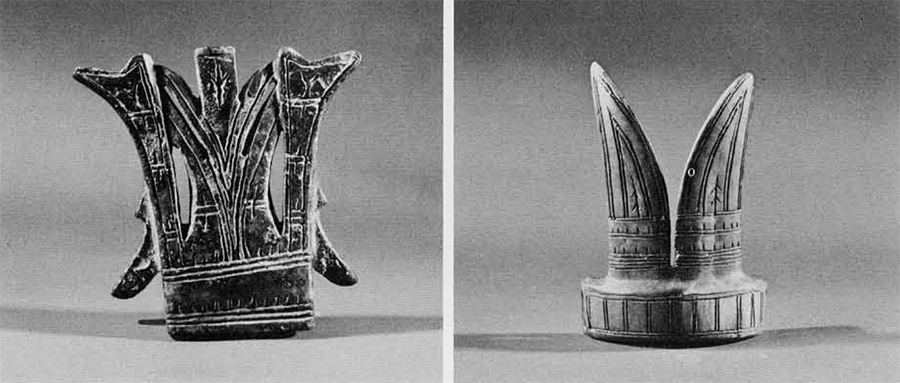

At the present stage of our knowledge it would appear that Okvik art is essentially a Siberian style. St. Lawrence and the Punuk Islands are geographically and culturally Siberian and the only known Okvik sites have been found on these islands and in northeastern Siberia. Only rare pieces have been found on the American side of the Strait.
The Punuk period, terminating about A.D. 1000, is the last recognizable stage in the early art of the North and at this time sculpture and engraving had become much more simple and more crude. Thereafter, with the beginning of the Thule period, very little art work of any kind was produced. Moreover, all of the implements and weapons of the Eskimo were heavier, cruder, and more clumsy than in the early periods. It is a curious fact that most of the manufactured objects of the rally periods have a light, delicate, elaborate quality which disappears, at least among the most northern Eskimos, after the wide spread of Thule period culture during the second millennium A.D.
In some regions such as Southampton Island in the eastern Arctic and in the southern Bering Sea region, these lighter, more delicate, and more skilfully designed implements continued to be made, and the skill in producing utilitarian objects was never lost by the Eskimos, but one familiar with Eskimo culture soon comes to distinguish most of the ancient from the modern implements simply by their size, weight, and skill of manufacture.
The “winged figure” illustrated here is most characteristic of Punuk work in carving and engraving. It is related to the winged objects of the Old Bering Sea period and may have been used as a weight on the butt of a throwing spear since it also has a socket in each end; but it was made at least five or six hundred years later. Engraved designs on this figure are like those on many of the Punuk harpoon heads and can be distinguished easily from earlier styles, although some of the design elements persist to this late date. We know that larger quantities of Siberian metal had reached Bering Strait during the Punuk period and that the idea of slat armor, like that worn by the Japanese, was introduced at this time. Punuk armor was made, however, of bone and ivory slats rather than metal. Considerable fighting must have taken place at this time since the Eskimos developed a particular type of arrow point for warfare alone. They also made wrist guards of ivory which were lashed to the wrist to protect it from the slap of the bow string.
While the really fine work ended a thousand years ago, some of the ancient skill in ivory carving was carried on into modern times, and wood carving, at least demonstrated in the elaborate dance masks of western Alaska, remained a very remarkable art form. Some Eskimo wooden masks made as late as the beginning of this century, are among the fines examples of contemporary native art to be found anywhere in the world.
All of the wooden masks shown here are of the spirit world. With each must have gone a vision, a song, and a dance. As a one-time crewman with the whaling boat of the Inyuelingmiut family at Point Hope and, as such, a kind of adopted member of the family, I cannot help but regret that the vast store of legend, learning , and belief which all these masks represent is lost to those who now collect them. Surely we would appreciate them more if we knew the vision behind them.
Old Nashugruk, an Eskimo woman of Point Hope, Alaska, was one of those ancient dames who spent the two summer months excavating ancient house ruins which adjoin her village. Some houses must have been built during the late Middle Ages, others as recently as the last century, but they are now abandoned to burrowing mice and the native collectors of antiquities. In the summer of 1939 she had dug deep into the rotting muck of the old town to the planked floor of a dance house and there she found a cache of some fifty wooden masks nicely preserved in frozen debris from the house roof. One of those masks is illustrated here. Helge Larsen of the Danish National Museum and I bargained with Nashugruk for most of the summer and finally succeeded in closing a trade for the masks with a pound of tobacco after supplies in the village had been exhausted.
The Episcopal Church naturally frowns upon masked dances which are meant to call up a host of pagan spirits, and so the deeply religious Eskimos of Point Hope today no longer carve these symbols of visions evoking the other world. But they remember them. David Frankson’s grandfather, Acetchuk, was one of the last great shamans before his conversion to Christianity in 1925 and he has left us a clear account of the vision experience which led to his acceptance into the profession. He was confirmed after he and his friends carved a set of masks with the features of his helping spirit, a man who had recently died and then appeared to Acetchuk as the captain of a skin boat, quietly floating through the air over the tundra. The spirit had a much distorted otherworldly face which the carvers reproduced in their masks, and a personal song which Acetchuk taught his friends so they could sing it with him when they danced his vision in the dance house of the Inyuelingmiut.
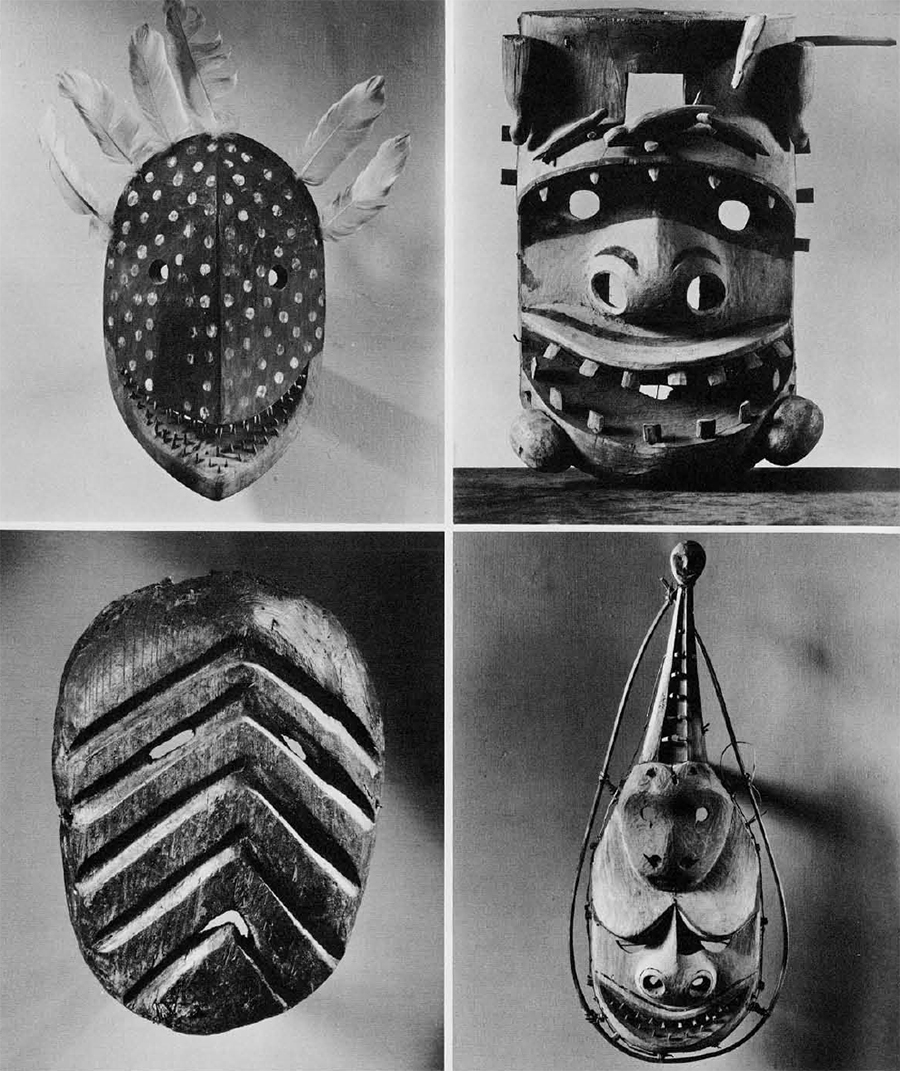

Acetchuk became such a powerful shaman that he eventuall gave birth to a kikituk, one of those monsters with sharp teeth which were directed to kill opposing shamans in deadly battles between the supernatural powers of the titans in the profession. Such a kikituk was also found by Nashugruk in the old dance house floor and it is now in the collection of the University of Alaska. It is made of wood with teeth of ivory. David explained how Acetchuk gave natural birth to such a creature at will during a seance and how he had used it to kill an exceedingly powerful shaman from Siberia.
Wooden masks are still carved by Eskimos of today and some may have merit as copies of the vital art form developed in the Arctic over the centuries– but they are meaningless in a true aesthetic sense. Today all Eskimos are Christians. The masks illustrated here are of the pre-Christian period, when the carvers worked with sincere belief in the supernatural forces, not only represented but embodied in such masks. Each is the result of an intense religious belief and the product of an ancient Eskimo world worldview which is incomprehensible to the Christian except as a work of art. It is the power of belief, I think, which makes all the difference between original native art and contemporary native craft.
